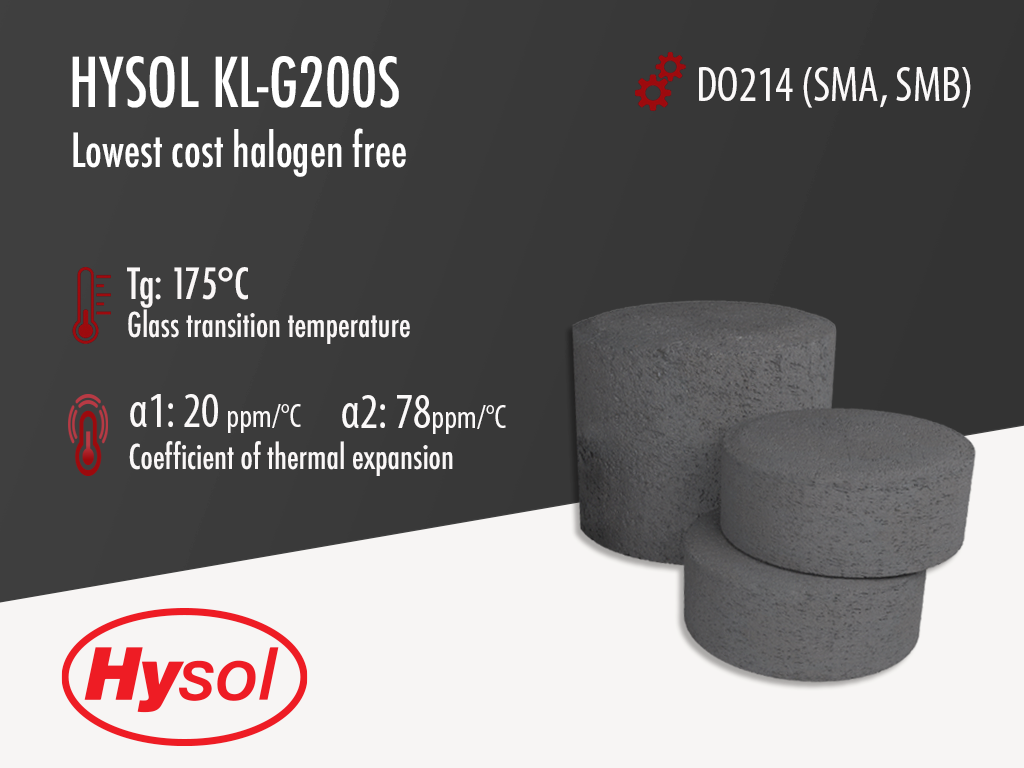Hysol KL-G200S | Black Epoxy Mold Compound
Harmonization Code : 3907.30.00.90 | Polyacetals, other polyethers and epoxide resins, in primary forms; polycarbonates, alkyd resins, polyallyl esters and other polyesters, in primary forms : Epoxide resins : Other
Main features
- MSL 1 260°C
- Low Cost of Ownership for Halogen free
- Designed for DO214 (SMA, SMB & SMX) packages
Product Description
Hysol KL-G200S is a black, halogen-free, semiconductor grade epoxy molding compound. It provides the lowest cost of ownership for a "non-halogen containing" epoxy molding compound. It works on surface mounted diodes such as D0214 in various sizes (SMA, SMB, SMC) and other low end discrete semiconductor and sensor packages.
Hysol KL-G200S passes MSL1 260°C. It is an epoxy molding compound that contains no bromine, antimony or phosphorus flame retardant. This product is designed to achieve JEDEC Level 1 requirements, at 260°C reflow temperature and provides the lowest cost of ownership with superior moldability and reliability. To top this up, it meets UL 94 V-0 Flammability at 6.35mm thickness.
Technical Specifications
| General Properties | |||||||||||||
| Color Color The color | Black | ||||||||||||
| Filler Content | 77 % | ||||||||||||
| Filler Size Cut | 75 µm | ||||||||||||
| Specific Gravity Specific Gravity Specific gravity (SG) is the ratio of the density of a substance to the density of a reference substance; equivalently, it is the ratio of the mass of a substance to the mass of a reference substance for the same given volume. For liquids, the reference substance is almost always water (1), while for gases, it is air (1.18) at room temperature. Specific gravity is unitless. | 1.95 | ||||||||||||
| |||||||||||||
| Physical Properties | |||||||||||||
| Spiral Flow @ 175°C | 80 cm | ||||||||||||
| Chemical Properties | |||||||||||||
| |||||||||||||
| Moisture absorption | 0.5 % | ||||||||||||
| Electrical Properties | |||||||||||||
| |||||||||||||
| |||||||||||||
| |||||||||||||
| Volume Resistivity Volume Resistivity Volume resistivity, also called volume resistance, bulk resistance or bulk resistivity is a thickness dependent measurement of the resistivity of a material perpendicular to the plane of the surface. | 1.8x1016 Ohms⋅cm | ||||||||||||
| Mechanical Properties | |||||||||||||
| |||||||||||||
| |||||||||||||
| |||||||||||||
| Molded Shrinkage | 0.26 % | ||||||||||||
| |||||||||||||
| Thermal Properties | |||||||||||||
| |||||||||||||
| |||||||||||||
| Glass Transition Temperature (Tg) Glass Transition Temperature (Tg) The glass transition temperature for organic adhesives is a temperature region where the polymers change from glassy and brittle to soft and rubbery. Increasing the temperature further continues the softening process as the viscosity drops too. Temperatures between the glass transition temperature and below the decomposition point of the adhesive are the best region for bonding. The glass-transition temperature Tg of a material characterizes the range of temperatures over which this glass transition occurs. | 175 °C | ||||||||||||
| Thermal Conductivity Thermal Conductivity Thermal conductivity describes the ability of a material to conduct heat. It is required by power packages in order to dissipate heat and maintain stable electrical performance. Thermal conductivity units are [W/(m K)] in the SI system and [Btu/(hr ft °F)] in the Imperial system. | 1.4 W/m.K | ||||||||||||
| UL 94 Rating UL 94 Rating Flammability rating classification. It determines how fast a material burns or extinguishes once it is ignited. HB: slow burning on a horizontal specimen; burning rate less than 76 mm/min for thickness less than 3 mm or burning stops before 100 mm V-2: burning stops within 30 seconds on a vertical specimen; drips of flaming particles are allowed. V-1: burning stops within 30 seconds on a vertical specimen; drips of particles allowed as long as they are not inflamed. V-0: burning stops within 10 seconds on a vertical specimen; drips of particles allowed as long as they are not inflamed. 5VB: burning stops within 60 seconds on a vertical specimen; no drips allowed; plaque specimens may develop a hole. 5VA: burning stops within 60 seconds on a vertical specimen; no drips allowed; plaque specimens may not develop a hole | V0 | ||||||||||||
| Curing Conditions | |||||||||||||
| |||||||||||||
| |||||||||||||
| Transfer Pressure | 40 - 100 kg/cm2 | ||||||||||||
| Transfer Time | 10 - 20 s | ||||||||||||





